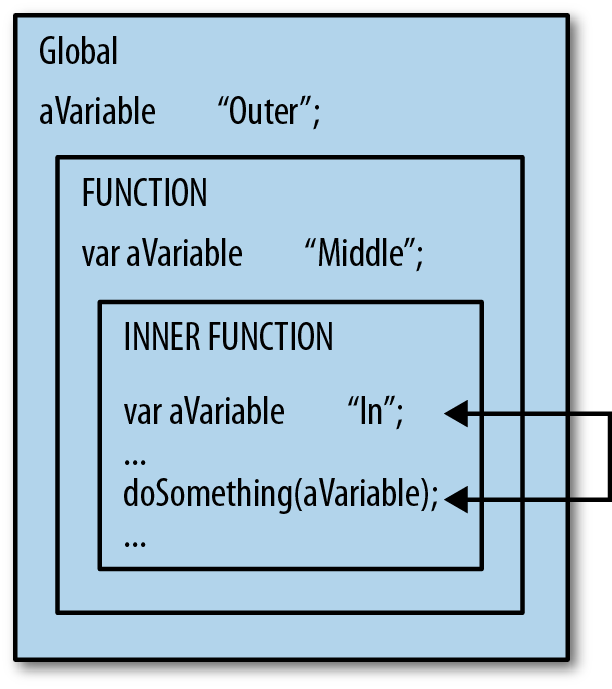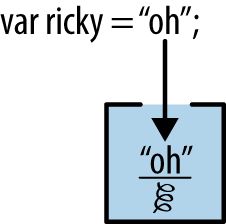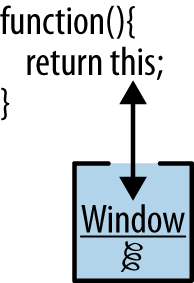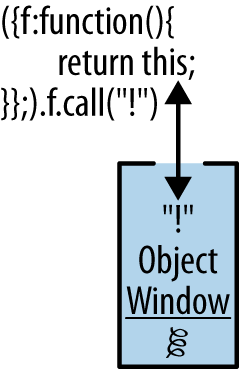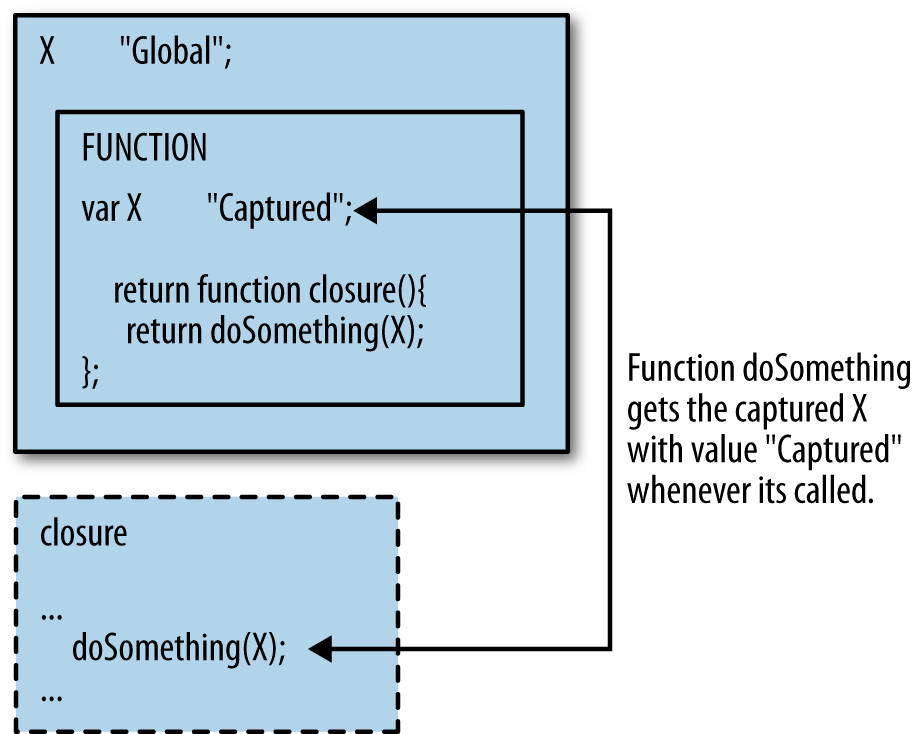This chapter introduces variable scope, an important foundational
topic not only to functional programming, but to JavaScript in general. The
term “binding” refers to the act of assigning a value to a name in
JavaScript via var assignment, function
arguments, this passing, and property
assignment. This chapter first touches on dynamic scoping, as displayed in
JavaScript’s this reference, and proceeds
onto function-level scoping and how it works. All of this builds up to a
discussion of closures, or functions that capture nearby variable bindings
when they are created. The mechanics of closures will be covered, along with
their general use cases and some examples.
The term “scope” has various meanings in common use among JavaScript programmers:
The value of the
thisbindingThe execution context defined by the value of the
thisbindingThe “lifetime” of a variable
The variable value resolution scheme, or the lexical bindings
For the purposes of this book, I’ll use scope to refer to the generic idea of the variable value resolution scheme. I’ll dig deeper into various types of resolution schemes to cover the full spectrum of scope provided by JavaScript, starting with the most straightforward: global scope.
The extent of a scope refers to the lifetime of a variable (i.e., how long a variable holds a certain value). I’ll start with variables with the longest lifespan—that of the “life” of the program itself—globals.
In JavaScript, the following variable would have global scope:
aGlobalVariable='livin la vida global';
Any variable declared in JavaScript without the var keyword is created in the global scope, or
the scope accessible to every function and method in our program.
Observe:
_.map(_.range(2),function(){returnaGlobalVariable});//=> ["livin la vida global", "livin la vida global"]
As shown, the variable aGlobalVariable is accessible from the anonymous
function (one created without a name) supplied to the _.map call. Global scope is simple to understand
and is used often in JavaScript programs (and sometimes with great
effect). In fact, Underscore creates a global named _ that contains all of its functions. Although
this may not provide the greatest name-spacing technique yet invented,
it’s what JavaScript uses, and Underscore at least provides an escape
hatch with the _.noConflict
function.
The funny thing about variables in JavaScript is that they are mutable by default (i.e., you can change their property values right in place):
aGlobalVariable='i drink your milkshake';aGlobalVariable;//=> "i drink your milkshake"
The problem with global variables, and the reason that they are so
reviled, is that any piece of code can change them for any reason at any
time. This anarchic condition can make for severe pain and missed
holidays. In any case, the idea of global scope and its dangers should be
known to you by now. However, being defined at the top of a file or
lacking a var is not all that it takes
for a variable to have global scope. Any object is wide open for change
(unless it’s frozen, which I’ll talk about in Chapter 7):
functionmakeEmptyObject(){returnnewObject();}
The makeEmptyObject function does
exactly what it says: it makes an empty object. I can attach all manner of
properties to the objects returned from this function, but so too can any
other piece of code that gets a reference to them. Any mutable object that
you pass around effectively allows change at a global scale on its
properties. Heck, if I wanted, I could change every function in the
Underscore object to return the string 'nerf
herder'—no one can stop me. This presents somewhat of a
challenge to functional programming in JavaScript. However, as I’ll show
throughout this book, there are ways to alleviate the problem of an
implicit global scope.
Just because a global variable holds a certain value for the entire life of a program doesn’t mean that when you refer to it you’ll get the global value. Scope becomes more interesting when we talk about something called lexical scope, described next.
Lexical scope refers to the visibility of a variable and its value analogous to its textual representation. For example, observe the following code:
aVariable="Outer";functionafun(){varaVariable="Middle";return_.map([1,2,3],function(e){varaVariable="In";return[aVariable,e].join(' ');});}
What is the value of a call to afun?
afun();//=> ["In 1", "In 2", "In 3"]
The innermost variable value, In,
takes precedence when used within the function passed to
_.map. Lexical scope dictates that since the assignment
aVariable to In occurs textually close to its innermost use,
then that is its value at the time of use. Figure 3-1
shows this condition graphically.
In the simple case, variable lookup starts at the closest binding context and expands outward until it finds a binding.[35] Figure 3-1 describes lexical scoping, or the grouping of names with values according to the surrounding source code. I will cover the mechanics of different lookup schemes supported by JavaScript over the course of this chapter, starting with dynamic scope.
One of the most underappreciated and over-abused concepts in programming is that of dynamic scoping. One reason for this is that very few languages use dynamic scope as their primary binding resolution scheme. Dynamic scoping, however, is a simplistic scheme used as the primary scoping mechanism in only a handful of modern programming languages, and has not seen widespread adoption outside of the earliest versions of Lisp.[36] Simulating a naive dynamic scoping mechanism requires very little code:
varglobals={};
First of all, dynamic scoping is built on the idea of a global table of named values.[37] At the heart of any JavaScript engine you will see—if not in implementation, then in spirit—one big honking lookup table:
functionmakeBindFun(resolver){returnfunction(k,v){varstack=globals[k]||[];globals[k]=resolver(stack,v);returnglobals;};}
With globals and makeBindFun in place, we can move onto the
policies for adding bindings to the globals variable:
varstackBinder=makeBindFun(function(stack,v){stack.push(v);returnstack;});varstackUnbinder=makeBindFun(function(stack){stack.pop();returnstack;});
The function stackBinder performs
a very simple task (i.e., it takes a key and a value and pushes the value
onto the global bindings map at the
slot associated with the key). Maintaining a global map of stacks
associated with binding names is the core of dynamic scoping, as shown in
Figure 3-2.
Figure 3-2. You can imagine that any time you declare a variable it comes with a little stack to hold its value; the current dynamic value is found at the top of the stack
The stackUnbinder function is the
antithesis of stackBinder in that it
pops the last value binding off of the stack associated with a name.
Finally, we’ll need a function to look up bound values:
vardynamicLookup=function(k){varslot=globals[k]||[];return_.last(slot);};
The dynamicLookup function
provides a convenient way to look up the value at the top of a named value
binding stack, and is used to simulate this reference resolution as you might visualize
it in Figure 3-3.
Figure 3-3. A lone function referencing “this” will deal with some global object (e.g., the window in the browser)
Now that our binding and lookup functions are defined, I can note the effects that various operations have on the simulated dynamic scope:
stackBinder('a',1);stackBinder('b',100);dynamicLookup('a');//=> 1globals;//=> {'a': [1], 'b': [100]}
So far, everything looks as you might expect in the preceding code.
Specifically, taking the keyed arrays in globals as stacks, you might see that since
a and b have been bound only once
each, the stacks would have only a single value inside. While dynamicLookup cannot easily simulate the
this resolution in an object method,
you can think of it as yet another push onto the stack, as shown in Figure 3-4.
In a dynamic scoping scheme, the value at the top of a stack in a binding is the current value. Let’s investigate what would happen if we bind again:
stackBinder('a','*');dynamicLookup('a');//=> '*'globals;//=> {'a': [1, '*'], 'b': [100]}
As you’ll notice, the new stack bound at a contains the stack [1, '*'], so any lookup occurring with that
condition will result in *. To retrieve
the previous binding is as simple as unbinding by popping the
stack:
stackUnbinder('a');dynamicLookup('a');//=> 1
You may already imagine (or know) how a scheme like this (i.e., the manipulation of global named stacks) may cause trouble, but if not observe the following:
functionf(){returndynamicLookup('a');};functiong(){stackBinder('a','g');returnf();};f();//=> 1g();//=> 'g'globals;// {a: [1, "g"], b: [100]}
Here we see that though f never
manipulated the binding of a, the value
that it saw was subject to the whim of its caller g! This is the poison of dynamic scoping: the
value of any given binding cannot be known until the caller of any given
function is known—which may be too late.
A point of note in the preceding code is that I had to explicitly “unbind” a dynamic binding, whereas in programming languages supporting dynamic binding this task is done automatically at the close of the dynamic binding’s context.
This section has not been an exercise in theory, but instead has
set up the discussion for the one area where dynamic scoping rules apply
to JavaScript, the this reference. In
Chapter 2, I mentioned that the this reference can point to different values
depending on the context in which it was first created, but it’s
actually much worse than that. Instead, the value of the this reference, like our binding of a, is also determined by the caller, as shown
in the following:
functionglobalThis(){returnthis;}globalThis();//=> some global object, probably WindowglobalThis.call('barnabas');//=> 'barnabas'globalThis.apply('orsulak',[])//=> 'orsulak'
Yep, the value of the this
reference is directly manipulable through the use of apply or call, as shown in Figure 3-5.
That is, whatever object is passed into them as the first argument
becomes the referenced object. Libraries like jQuery use this as a way
to pass context objects and event targets into first-class functions,
and as long as you keep your wits about you, it can prove to be a
powerful technique. However, dynamic scope can confuse this.
Thankfully, this problem does not arise if a this reference is never passed to call or apply, or if it is bound to null. Additionally, Underscore provides the
function _.bind that allows you to
lock the this reference from
changing, like the following:
varnopeThis=_.bind(globalThis,'nope');nopeThis.call('wat');//=> 'nope';
Because the this reference is
dynamically scoped, you may often find, especially in the case of event
handling functions, that the this you
get on something like a button click is not useful and may break your
app. To tackle a problem like this, you can use the _.bindAll function to lock the this reference to a stable value for all of
the named methods, as shown here:
vartarget={name:'the right value',aux:function(){returnthis.name;},act:function(){returnthis.aux();}};target.act.call('wat');// TypeError: Object [object String] has no method 'aux'_.bindAll(target,'aux','act');target.act.call('wat');//=> 'the right value'
And thus, Underscore saves us from the perils of dynamic scoping. Now that I’ve covered dynamic scope in detail, it’s high time to cover function scope.
In order to illustrate the difference between dynamic and function scoping, I’ll need to modify the logic for binding and lookup. Instead of accessing bindings in a global hash map, the new model will instead require that all bindings be constrained to the smallest area possible (namely, the function). This follows the scoping model adhered to by JavaScript.[38]
To simulate a function scoping scheme requires a bit of imagination.
As you know, each JavaScript function can refer to a this reference. In the previous section, I
talked about the dangers of the dynamic nature of this, but for the sake of illustration, I’ll use
it to prove a different point. First, observe how JavaScript acts by
default:
functionstrangeIdentity(n){// intentionally strangefor(vari=0;i<n;i++);returni;}strangeIdentity(138);//=> 138
In a language like Java, an attempt to access a variable like
i, defined locally to a for block, would provoke an access error.
However, in JavaScript, all var
declarations in a function body are implicitly moved to the top of the
function in which they occur. The action of JavaScript to rearrange
variable declarations is called hoisting. In other
words, the previously defined function would become something
like:[39]
functionstrangeIdentity(n){vari;for(i=0;i<n;i++);returni;}
The implications of this are that any piece of code in the function can see all of the variables defined inside. Needless to say, this can cause problems at times, especially if you are not careful about how the variables are captured via closures (discussed in the following section).
In the meantime, I can show how function scope can be simulated
quite easily by using the this
reference:
functionstrangerIdentity(n){// intentionally stranger stillfor(this['i']=0;this['i']<n;this['i']++);returnthis['i'];}strangerIdentity(108);//=> 108
Of course, this is not a true simulation because in this circumstance I’ve actually modified the global object:
i;//=> 108
Whoops! Instead, it would be more precise to supply a scratch space
for the function to operate on, and thanks to the magic of the this reference, I can supply it on the
call:
strangerIdentity.call({},10000);//=> 10000i;//=> 108
Although our original global i
persists, at least I’ve stopped modifying the global environment. I’ve
again not provided a true simulator, because now I can only access locals
inside of functions. However, there is no reason that I need to pass in an
empty object as context. In fact, in this faked-out JavaScript, it would
be more appropriate to pass in the global context, but not directly, or
else I’d be back in the soup. Instead, a clone should do:
functionf(){this['a']=200;returnthis['a']+this['b'];}varglobals={'b':2};f.call(_.clone(globals));//=> 202
And checking the global context proves clean:
globals;//=> {'b': 2}
This model is a reasonable facsimile of how function scoping
operates. For all intents and purposes, this is precisely what JavaScript
does, except variable access is done implicitly within the function body
instead of requiring an explicit lookup in this. Regardless of your thoughts about
function-level scoping, at least JavaScript takes care of the underlying
machinery for us—small victories and all that.
JavaScript closures are one of life’s great mysteries. A recent survey on total Internet size places blog posts about JavaScript closures at around 23%.[40]
I kid. Closures, for whatever reason, remain a mystery to a substantial number of programmers for numerous reasons. In this section, I will take some time to go into detail on closures in JavaScript, but thankfully for you, they’re quite simple. In fact, throughout this section, I’ll build a small library that simulates scoping rules and closures. I’ll then use this library to explore the details of this chapter, which include global scope, function scope, free variables, and closures.
To start, it’s worth mentioning that closures go hand in hand with first-class functions. Languages without first-class functions can support closures, but they’re often greatly stunted. Thankfully, JavaScript supports first-class functions, so its closures are a powerful way to pass around ad hoc encapsulated states.
Note
For the remainder of this chapter and the next, I will capitalize all of the variables that are captured by a closure. This is in no way standard practice in the JavaScript you’re likely to see in the wild, nor an endorsement of such activity, but only meant to teach. After these two chapters I will no longer use this convention.
Having said all of that, a closure is a function that “captures” values near where it was born. Figure 3-6 is a graphical representation of a closure.
In the next few sections, I’ll cover closures in depth, starting with a closure simulator.
It took only 30 years, but closures are finally becoming a key feature of mainstream programming languages. What is a closure? In a sentence, a closure is a function that captures the external bindings (i.e., not its own arguments) contained in the scope in which it was defined for later use (even after that scope has completed).
Before we go any further with how to simulate closures, let’s take a look at how they behave by default. The simplest example of a closure is a first-class function that captures a local variable for later use:
functionwhatWasTheLocal(){varCAPTURED="Oh hai";returnfunction(){return"The local was: "+CAPTURED;};}
Using the whatWasTheLocal
function is as follows:
varreportLocal=whatWasTheLocal();
I’ve already talked about how function-local variables live only for the lifetime of a function’s body, but when a closure captures a variable, it’s able to live for an indeterminate extent:[41]
reportLocal();//=> "The local was: Oh hai"
So it seems that the local variable CAPTURED was able to travel with the closure
returned by whatWasTheLocal—indeed,
this is effectively what happened. But local variables are not the only
things that can be captured. As shown here, function arguments can be
captured as well:
functioncreateScaleFunction(FACTOR){returnfunction(v){return_.map(v,function(n){return(n*FACTOR);});};}varscale10=createScaleFunction(10);scale10([1,2,3]);//=> [10, 20, 30]
The function createScaleFunction takes a scaling factor and
returns a function that, given a collection of numbers, returns a list
of its elements multiplied by the original scaling factor. As you may
have noticed, the returned function refers to a variable FACTOR that seemingly falls out of scope once
the createScaleFunction function
exits. This observation is only partially true because in fact, the
variable FACTOR is retained within
the body of the return scaling function and is accessible anytime that
function is called. This variable retention is precisely the definition
of a closure.
So how would we simulate a closure using our function-scoped
this scratchpad from the previous
section? First of all, I’ll need to devise a way for capturing closed
variables while simultaneously maintaining access to non-closed
variables normally. The most straightforward way to do that is to grab
the variables defined in the outer function individually and bind them
to the this of the returned function,
as in the following:
functioncreateWeirdScaleFunction(FACTOR){returnfunction(v){this['FACTOR']=FACTOR;varcaptures=this;return_.map(v,_.bind(function(n){return(n*this['FACTOR']);},captures));};}varscale10=createWeirdScaleFunction(10);scale10.call({},[5,6,7]);//=> [50, 60, 70];
Wow, keeping track of which variables are needed within the body of inner functions seems like a real pain. If you needed to keep track manually, like in this example, then JavaScript would be exceedingly difficult to write.[42] Thankfully for us, the machinery driving variable capture is automatic and straightforward to use.
Free variables are related to closures in that it is the free variables that will be closed over in the creation of said closure. The basic principle behind closures is that if a function contains inner functions, then they can all see the variables declared therein; these variables are called “free” variables.[43] However, these variables can be grabbed and carried along for later use in inner functions that “escape” from a higher-level function via return.[44] The only caveat is that the capturing function must be defined within the outer function for the capture to occur. Variables used in the body of any function without prior local declaration (neither passed into, nor defined locally) within a function are then captured variables. Observe:
functionmakeAdder(CAPTURED){returnfunction(free){returnfree+CAPTURED;};}varadd10=makeAdder(10);add10(32);//=> 42
The variable CAPTURED in the
outer function is indeed captured in the returned function performing
the addition because the inner never declares CAPTURED, but refers to it anyway.
Thereafter, the function returned from makeAdder retains the variable CAPTURED that was captured when it
was created and uses it in its calculation. Creating another adder
will capture the same named variable CAPTURED but with a different value, because
it will be created during a later invocation of makeAdder:
varadd1024=makeAdder(1024);add1024(11);//=> 1035add10(98);//=> 108
And finally, as shown in the preceding code, each new adder
function retains its own unique instance of CAPTURED—the one captured when each was
created. The value captured can be of any type, including another
function. The following function, averageDamp, captures a function and returns
a function that calculates the average of some value and the result of
passing it to the captured function:[45]
functionaverageDamp(FUN){returnfunction(n){returnaverage([n,FUN(n)]);}}varaverageSq=averageDamp(function(n){returnn*n});averageSq(10);//=> 55
Higher-order functions that capture other functions are a very powerful technique for building abstractions. I will perform this kind of act throughout the course of this book to great effect.
What happens if you create a function with a variable named the same as a variable in a higher scope? I’ll talk briefly about this presently.
Variable shadowing happens in JavaScript when a variable of name
x is declared within a certain
scope and then another variable of the same name is declared later in
a lower scope. Observe a simple example of shadowing:
varname="Fogus";varname="Renamed";name;//=> "Renamed"
That two consecutive declarations of variables with the same name assign the value of the second should be no surprise. However, shadowing via function parameters is where the complexity level rises:
varshadowed=0;functionargShadow(shadowed){return["Value is",shadowed].join(' ');}
What do you think is the value of the function call argShadow(108)? Observe:
argShadow(108)//=> "Value is 108"argShadow();//=> "Value is "
The argument named shadowed
in the function argShadow overrides
the value assigned to the same named variable at the global scope.
Even when no arguments are passed, the binding for shadowed is still set. In any case, the
“closest” variable binding takes precedence. You can also see this in
action via the use of var:
varshadowed=0;functionvarShadow(shadowed){varshadowed=4320000;return["Value is",shadowed].join(' ');}
If you guessed the value returned value of varShadow(108) is now "Value is 4320000" then you’re absolutely
correct. Shadowed variables are also carried along with closures, as
shown in the following:
functioncaptureShadow(SHADOWED){returnfunction(SHADOWED){returnSHADOWED+1;};}varclosureShadow=captureShadow(108);closureShadow(2);//=> 3 (it would stink if I were expecting 109 here)
I tend to avoid shadowed variables when writing JavaScript code, but I do so only via careful attention to naming. If you’re not careful, then shadowing can cause confusion if you’ve not accounted for it. I’ll now move on to some quick closure usage examples before wrapping up this chapter.
In this section, I’ll touch briefly on the cases for using closures. Since the remainder of the book will use closures extensively, there’s no need for me to belabor the point, but it’s useful to show a few in action.
If you recall from Other Examples of Applicative Programming, the function
complement took a predicate function
and returned a new function that returned its opposite truthiness. While
I glossed over the fact at the time, complement used a closure to great effect.
Rewriting to illustrate the closure:
functioncomplement(PRED){returnfunction(){return!PRED.apply(null,_.toArray(arguments));};}
The PRED predicate is captured
by the returned function. Take the case of a predicate that checks for
evenness:
functionisEven(n){return(n%2)===0}
We can use complement to now
define isOdd:
varisOdd=complement(isEven);isOdd(2);//=> falseisOdd(413);//=> true
But what happens if the definition of isEven changes at some later time?
functionisEven(n){returnfalse}isEven(10);//=> false
Will this change the behavior of isOdd? Observe:
isOdd(13);//=> true;isOdd(12);//=> false
As you can see, the capture of a variable in a closure grabs the
reference of the captured thing (in this case, the predicate PRED) at the time that the closure is created.
Since I created a new reference for isEven by creating a fresh variable, the
change was transparent to the closure isOdd. Let’s run this to ground:
functionshowObject(OBJ){returnfunction(){returnOBJ;};}varo={a:42};varshowO=showObject(o);showO();//=> {a: 42};
Everything is fine and good, no? Well, not exactly:
o.newField=108;showO();//=> {a: 42, newField: 108};
Since the reference to o exists
inside and outside of the closure, its changes can be communicated
across seemingly private boundaries. This is potentially a recipe for
confusion, so the typical use case minimizes the exposure of captured
variables. A pattern you will see very often in JavaScript is to use
captured variables as private data:
varpingpong=(function(){varPRIVATE=0;return{inc:function(n){returnPRIVATE+=n;},dec:function(n){returnPRIVATE-=n;}};})();
The object pingpong is
constructed within the anonymous function serving as a scope block, and
contains two closures inc and
dec. The interesting part is that the
captured variable PRIVATE is private
to the two closures and cannot be accessed through any means but by
calling one of the two functions:
pingpong.inc(10);//=> 10pingpong.dec(7);//=> 3
Even adding another function is safe:
pingpong.div=function(n){returnPRIVATE/n};pingpong.div(3);// ReferenceError: PRIVATE is not defined
The access protection provided by this closure pattern is a powerful technique available to JavaScript programmers for keeping sanity in the face of software complexity.
While closures provide for private access in JavaScript, they are
a wonderful way to offer abstraction (i.e., closures often allow you to
create functions based solely on some “configuration” captured at
creation time). The implementations of makeAdder and complement are good examples of this
technique. Another example is a function named plucker that takes a key into an associative
structure—such as an array or an object—and returns a function that,
given a structure, returns the value at the key. The implementation is
as follows:
functionplucker(FIELD){returnfunction(obj){return(obj&&obj[FIELD]);};}
Testing the implementation reveals its behavior:
varbest={title:"Infinite Jest",author:"DFW"};vargetTitle=plucker('title');getTitle(best);//=> "Infinite Jest"
As I mentioned, plucker also
works with arrays:
varbooks=[{title:"Chthon"},{stars:5},{title:"Botchan"}];varthird=plucker(2);third(books);//=> {title: "Botchan"}
plucker comes in handy in
conjunction with _.filter, which is
used to grab objects in an array with a certain field:
_.filter(books,getTitle);//=> [{title: "Chthon"}, {title: "Botchan"}]
As this book proceeds, I will explore other uses and advantages of closures, but for now I think the groundwork for understanding them has been laid.
This chapter focused on two foundational topics not only in JavaScript, but also for functional programming in general: variable scope and closures.
The focus on variable scope started with global scope, the largest
available to JavaScript, and worked its way inward through lexical scope
and function scope. Additionally, I covered dynamic scoping, especially as
it manifests in the use and behavior of the this reference, based on the use of the call and apply methods. While potentially confusing, the
dynamic this could be fixed to a
certain value using Underscore’s _.bind
and _.bindAll functions.
My coverage of closures focused on how you could simulate them in a
language with all of JavaScript’s features, including the dynamic this. After simulating closures, I showed how to
not only use closures in your own functions, but also how they can be
viewed as a way to “tweak” existing functions to derive new functional
abstractions.
In the next chapter, I will expand on first-class functions and delve into higher-order functions, defined in terms of these points:
Functions can be passed to other functions
Functions can be returned from functions
If you’re unclear about the content of this chapter, then you might want to go back and reread before proceeding on to the next chapter. Much of the power of higher-order functions is realized in concert with variable scoping, and especially closures.
[35] There are other scoping modes that JavaScript provides that
complicate lookup, including this
resolution, function-level scope, and with blocks. I plan to cover all but the
last of these.
[36] To get a feel for what the early Lisps had to offer, read “Recursive Functions of Symbolic Expressions and Their Computation by Machine, Part I” by John McCarthy and the “LISP 1.5 Programmer’s Manual” by McCarthy, Abrahams, Edwards, Hart, and Levin.
[37] This is only one way to implement dynamic scoping, but it is likely the simplest.
[38] The ECMAScript.next activity has defined
numerous ways to define “lexical”
variable scoping. Lexical scoping works similarly to function
scoping except that it’s “tighter.” That is, it binds variables within
JavaScript blocks and does not raise the declaration to the top of
function bodies. I will not go into detail about lexical scoping here,
but it’s a topic well worth studying yourself.
[39] The ECMAScript.next initiative is working
through the specification of block-scope that would provide another
level of scoping finer-grained than function scope. It’s unclear when
this feature will make it into JavaScript core. Its eventual inclusion
should help justify the next edition of this book (crossing
fingers).
[40] If you factor in the commentary on Hacker News, it’s closer to 36%. I have no citation for this because I just made it up for fun.
[41] Closures are the programming language equivalent of vampires—they capture minions and give them everlasting life until they themselves are destroyed. The only difference is that closures don’t sparkle when exposed to sunlight.
[42] I could just refer directly to captures instead of dynamically passing it
to the inner function passed to map via Underscore’s bind, but then I would be using a closure
to simulate a closure! That’s cheating.
[43] Not free as in beer, and not free as in freedom, but instead free as in theft.

